Solar eclipse of March 20, 2034
| Solar eclipse of March 20, 2034 | |
|---|---|
 Map | |
| Type of eclipse | |
| Nature | Total |
| Gamma | 0.2894 |
| Magnitude | 1.0458 |
| Maximum eclipse | |
| Duration | 249 sec (4 m 9 s) |
| Coordinates | 16°06′N 22°12′E / 16.1°N 22.2°E |
| Max. width of band | 159 km (99 mi) |
| Times (UTC) | |
| Greatest eclipse | 10:18:45 |
| References | |
| Saros | 130 (53 of 73) |
| Catalog # (SE5000) | 9583 |
A total solar eclipse will occur on March 20, 2034. A solar eclipse occurs when the Moon passes between Earth and the Sun, thereby totally or partly obscuring the image of the Sun for a viewer on Earth. A total solar eclipse occurs when the Moon's apparent diameter is larger than the Sun's, blocking all direct sunlight, turning day into darkness. Totality occurs in a narrow path across Earth's surface, with the partial solar eclipse visible over a surrounding region thousands of kilometres wide.
Images

Animated path
Related eclipses
Solar eclipses of 2033-2036
Each member in a semester series of solar eclipses repeats approximately every 177 days and 4 hours (a semester) at alternating nodes of the Moon's orbit.
| Solar eclipse series sets from 2033-2036 | ||||||
|---|---|---|---|---|---|---|
| Ascending node | Descending node | |||||
| 120 | March 30, 2033 Total |
125 | September 23, 2033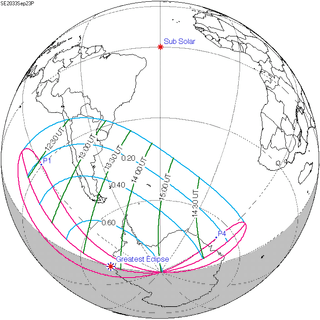 Partial | |||
| 130 | March 20, 2034 Total |
136 | September 12, 2034 Annular | |||
| 140 | March 9, 2035 Annular |
145 | September 2, 2035 Total | |||
| 150 | February 27, 2036 Partial |
155 | August 21, 2036 Partial | |||
| A partial solar eclipse on July 23, 2036 occurs in the next lunar year eclipse set. | ||||||
Saros 130
It is a part of Saros cycle 130, repeating every 18 years, 11 days, containing 73 events. The series started with partial solar eclipse on August 20, 1096. It contains total eclipses from April 5, 1475 through July 18, 2232. The series ends at member 73 as a partial eclipse on October 25, 2394. The longest duration of totality was 6 minutes, 41 seconds on July 11, 1619.[1]
| Series members 43–56 between 1853 and 2100 | ||
|---|---|---|
| 43 | 44 | 45 |
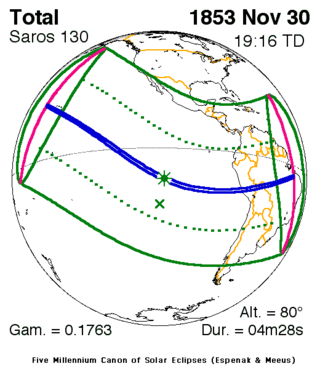 November 30, 1853 |
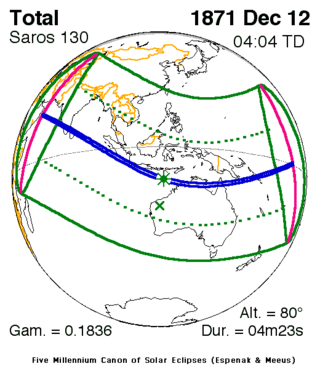 December 12, 1871 |
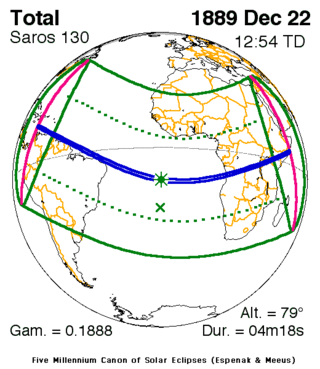 December 22, 1889 |
| 46 | 47 | 48 |
 January 3, 1908 |
 January 14, 1926 |
 January 25, 1944 |
| 49 | 50 | 51 |
 February 5, 1962 |
 February 16, 1980 |
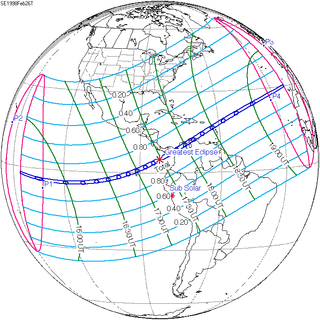 February 26, 1998 |
| 52 | 53 | 54 |
 March 9, 2016 |
 March 20, 2034 |
 March 30, 2052 |
| 55 | 56 | |
 April 11, 2070 |
 April 21, 2088 | |
Metonic series
The metonic series repeats eclipses every 19 years (6939.69 days), lasting about 5 cycles. Eclipses occur in nearly the same calendar date. In addition the octon subseries repeats 1/5 of that or every 3.8 years (1387.94 days).
| 21 eclipse events between June 1, 2011 and June 1, 2087 | ||||
|---|---|---|---|---|
| May 31 – June 1 | March 19–20 | January 5–6 | October 24–25 | August 12–13 |
| 118 | 119 | 121 | 123 | 125 |
 June 1, 2011 |
 March 20, 2015 |
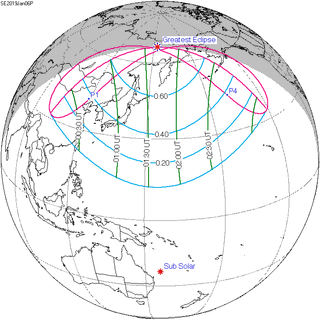 January 6, 2019 |
 October 25, 2022 |
 August 12, 2026 |
| 128 | 129 | 131 | 133 | 135 |
 June 1, 2030 |
 March 20, 2034 |
 January 5, 2038 |
 October 25, 2041 |
 August 12, 2045 |
| 138 | 139 | 141 | 143 | 145 |
 May 31, 2049 |
 March 20, 2053 |
 January 5, 2057 |
 October 24, 2060 |
 August 12, 2064 |
| 148 | 149 | 151 | 153 | 155 |
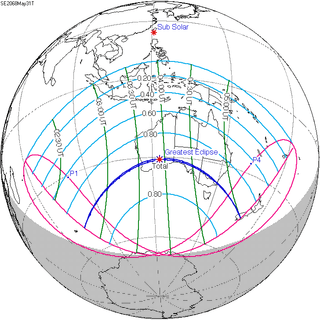 May 31, 2068 |
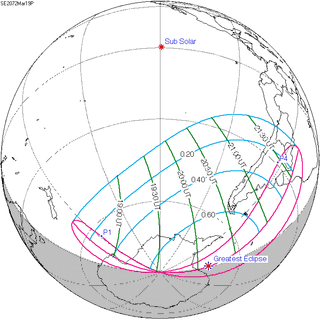 March 19, 2072 |
 January 6, 2076 |
 October 24, 2079 |
 August 13, 2083 |
| 157 | ||||
 June 1, 2087 | ||||
References
| Wikimedia Commons has media related to Solar eclipse of 2034 March 20. |
